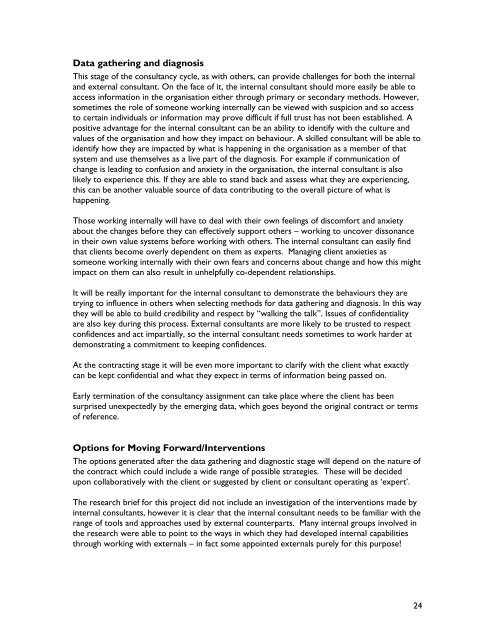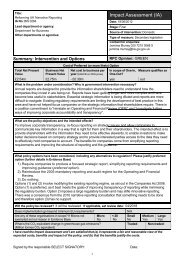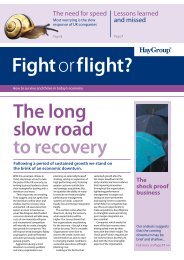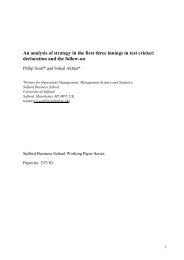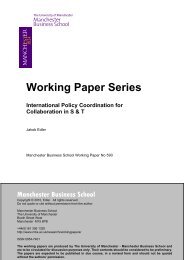The Role of the Internal Consultant - Management & Business ...
The Role of the Internal Consultant - Management & Business ...
The Role of the Internal Consultant - Management & Business ...
- No tags were found...
Create successful ePaper yourself
Turn your PDF publications into a flip-book with our unique Google optimized e-Paper software.
Data ga<strong>the</strong>ring and diagnosisThis stage <strong>of</strong> <strong>the</strong> consultancy cycle, as with o<strong>the</strong>rs, can provide challenges for both <strong>the</strong> internaland external consultant. On <strong>the</strong> face <strong>of</strong> it, <strong>the</strong> internal consultant should more easily be able toaccess information in <strong>the</strong> organisation ei<strong>the</strong>r through primary or secondary methods. However,sometimes <strong>the</strong> role <strong>of</strong> someone working internally can be viewed with suspicion and so accessto certain individuals or information may prove difficult if full trust has not been established. Apositive advantage for <strong>the</strong> internal consultant can be an ability to identify with <strong>the</strong> culture andvalues <strong>of</strong> <strong>the</strong> organisation and how <strong>the</strong>y impact on behaviour. A skilled consultant will be able toidentify how <strong>the</strong>y are impacted by what is happening in <strong>the</strong> organisation as a member <strong>of</strong> thatsystem and use <strong>the</strong>mselves as a live part <strong>of</strong> <strong>the</strong> diagnosis. For example if communication <strong>of</strong>change is leading to confusion and anxiety in <strong>the</strong> organisation, <strong>the</strong> internal consultant is alsolikely to experience this. If <strong>the</strong>y are able to stand back and assess what <strong>the</strong>y are experiencing,this can be ano<strong>the</strong>r valuable source <strong>of</strong> data contributing to <strong>the</strong> overall picture <strong>of</strong> what ishappening.Those working internally will have to deal with <strong>the</strong>ir own feelings <strong>of</strong> discomfort and anxietyabout <strong>the</strong> changes before <strong>the</strong>y can effectively support o<strong>the</strong>rs – working to uncover dissonancein <strong>the</strong>ir own value systems before working with o<strong>the</strong>rs. <strong>The</strong> internal consultant can easily findthat clients become overly dependent on <strong>the</strong>m as experts. Managing client anxieties assomeone working internally with <strong>the</strong>ir own fears and concerns about change and how this mightimpact on <strong>the</strong>m can also result in unhelpfully co-dependent relationships.It will be really important for <strong>the</strong> internal consultant to demonstrate <strong>the</strong> behaviours <strong>the</strong>y aretrying to influence in o<strong>the</strong>rs when selecting methods for data ga<strong>the</strong>ring and diagnosis. In this way<strong>the</strong>y will be able to build credibility and respect by “walking <strong>the</strong> talk”. Issues <strong>of</strong> confidentialityare also key during this process. External consultants are more likely to be trusted to respectconfidences and act impartially, so <strong>the</strong> internal consultant needs sometimes to work harder atdemonstrating a commitment to keeping confidences.At <strong>the</strong> contracting stage it will be even more important to clarify with <strong>the</strong> client what exactlycan be kept confidential and what <strong>the</strong>y expect in terms <strong>of</strong> information being passed on.Early termination <strong>of</strong> <strong>the</strong> consultancy assignment can take place where <strong>the</strong> client has beensurprised unexpectedly by <strong>the</strong> emerging data, which goes beyond <strong>the</strong> original contract or terms<strong>of</strong> reference.Options for Moving Forward/Interventions<strong>The</strong> options generated after <strong>the</strong> data ga<strong>the</strong>ring and diagnostic stage will depend on <strong>the</strong> nature <strong>of</strong><strong>the</strong> contract which could include a wide range <strong>of</strong> possible strategies. <strong>The</strong>se will be decidedupon collaboratively with <strong>the</strong> client or suggested by client or consultant operating as ‘expert’.<strong>The</strong> research brief for this project did not include an investigation <strong>of</strong> <strong>the</strong> interventions made byinternal consultants, however it is clear that <strong>the</strong> internal consultant needs to be familiar with <strong>the</strong>range <strong>of</strong> tools and approaches used by external counterparts. Many internal groups involved in<strong>the</strong> research were able to point to <strong>the</strong> ways in which <strong>the</strong>y had developed internal capabilitiesthrough working with externals – in fact some appointed externals purely for this purpose!24


